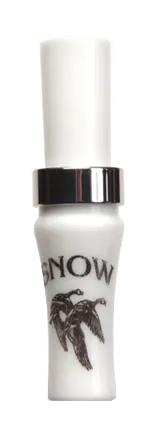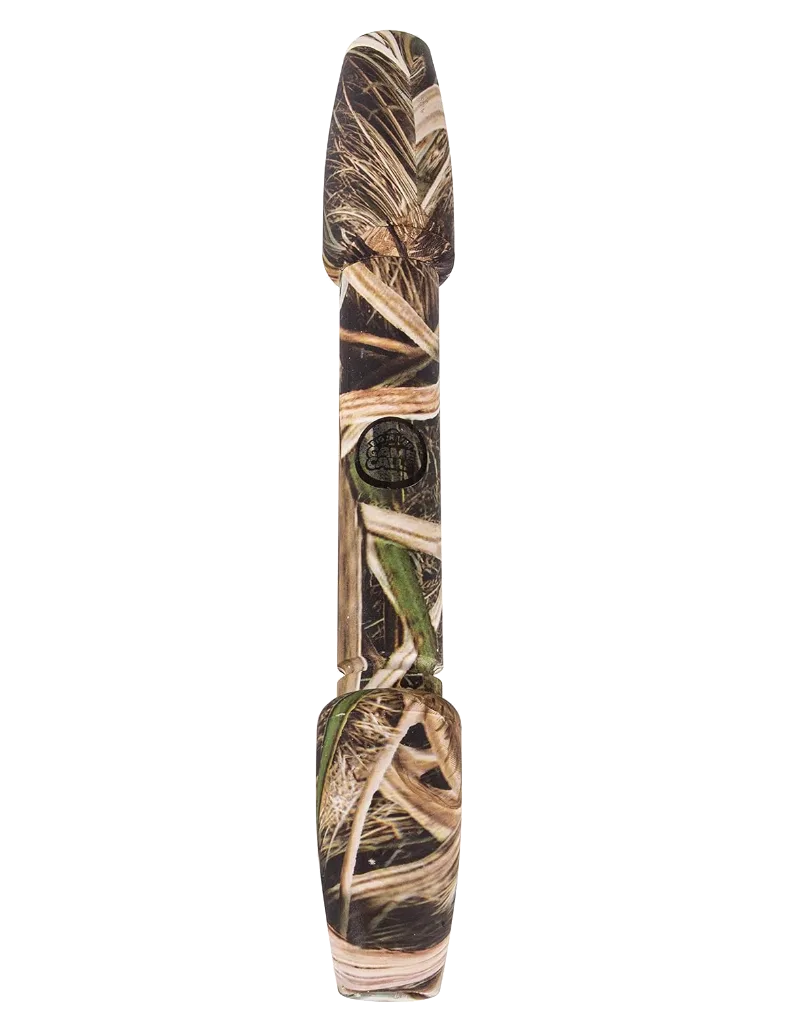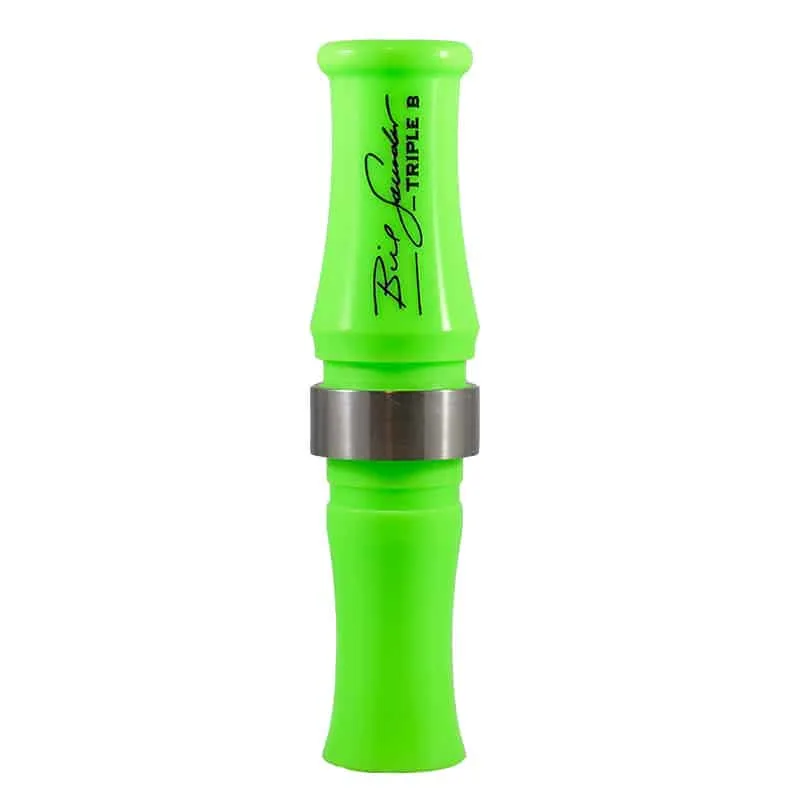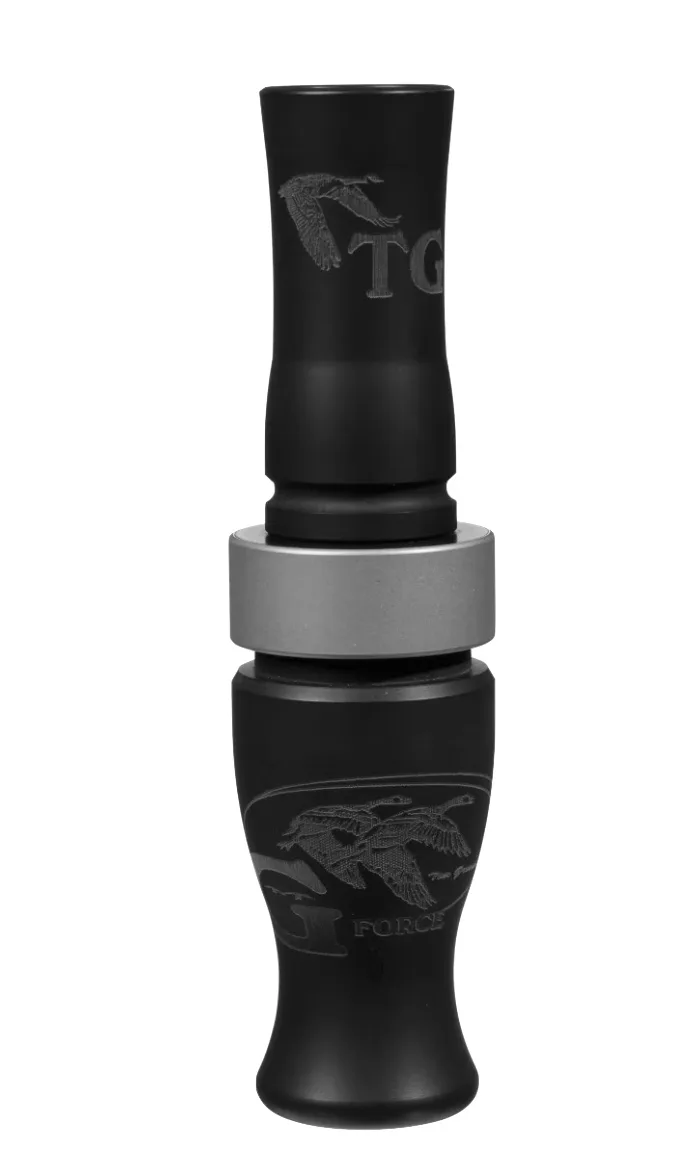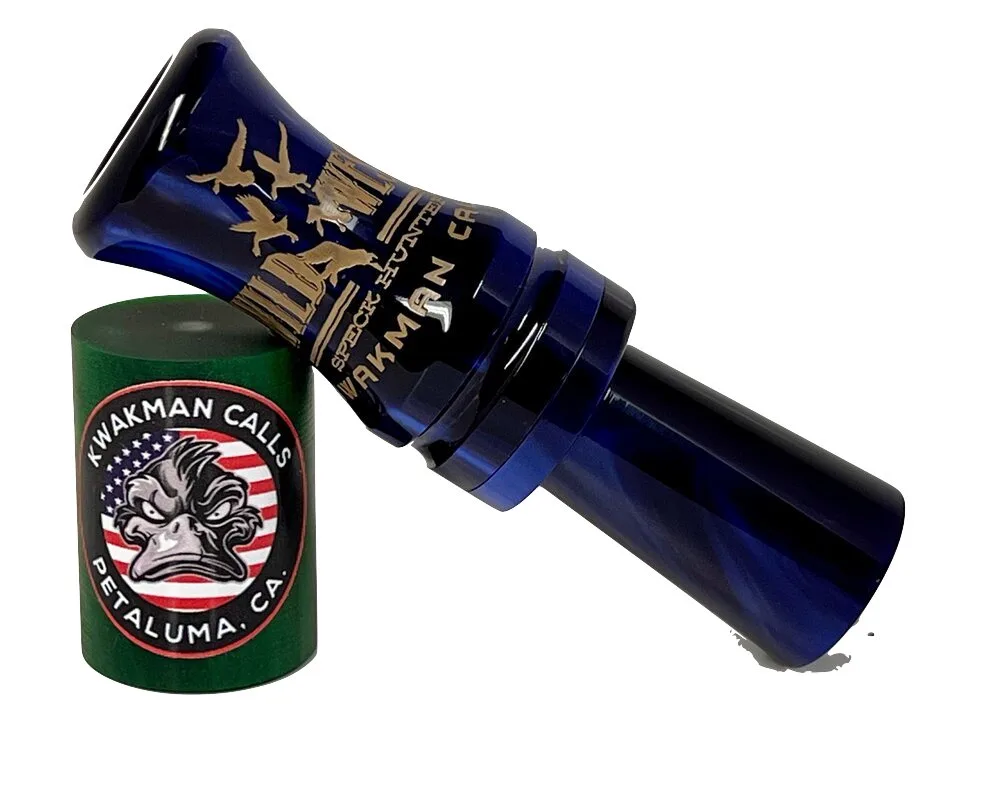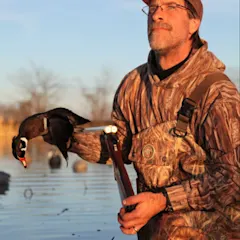We may earn revenue from the products available on this page and participate in affiliate programs. Learn more ›
I didn’t use any goose calls when I killed my first Canada goose in 1979. No decoys either. Just me, an inexperienced 15-year-old, hiding in my grandfather’s cornfield with my Pop’s ’66 Mossberg M500 and No. 4 shot. Right before the close of legal shooting time, a group of 30 honkers en route to their evening roost made the mistake of passing directly overhead. It took one shot, and my inaugural Canada fell among the stalks.
Forty-three years later, my goose hunting is radically different than it was in 1979. Intensive scouting. Layout blinds. Ultra-realistic full-body decoys. Photo-imagery silhouettes. And, of course, a variety of calls. Works of art from the shops of legends like the late Tim Grounds, Bill Saunders, Sean Mann, Fred Zink, and a long list of others. But which goose call is best for what you hunt, where you hunt, and your skill level? We rounded up some of the best goose calls to help you make that decision.
The Best Goose Calls
Best Overall: Sean Mann’s Eastern Shoreman XP-1
Best Speck/Snow Goose Call: Tim Grounds’ Snow/Speck
Most for Versatility: Bill Saunders’ Traffic
Best Wooden Call: Faulks’ H-100
Best Budget: Big River Long Honker
The Rest of the Best Goose Calls

How We Picked the Best Goose Calls
What am I looking for in a goose call? First, it’s got to sound like a real live goose. Whatever the species—greaters, lesers, snows, specks—I need to be able to approximate the vocals of said goose with that call. Second is the UFR, or what I refer to as the user-friendliness rating. In other words, how easy is the call to blow? I don’t expect to be a World Champion Caller out of the gate; however, I am looking for a call with a comparatively shallow learning curve. Something I can grow into without devoting my entire life to that piece of wood, acrylic, or polycarbonate.
Then there’s service after the sale, which to me includes some degree of instruction or education. Can I send the call back to the maker for re-tuning? Are there lessons, per se, on the website where I can listen to the sounds that are supposed to be emanating from the call?
For this piece, I considered my experiences with the manufacturers who make these calls and what others have said. I also asked the makers how they felt about fielding calls/questions after the sale.
And finally, there’s price. To some, I realize that money isn’t the main variable. To many, though, it’s without question a consideration. A decent flute-style call will run $25 to $40, while a higher-end acrylic short reed might cost $175. To me, the money spent depends on budget, skill level (or hoped-for skill level), and how much you plan on using the call.
The Best Goose Calls: Reviews & Recommendations
Best Overall: Sean Mann’s Eastern Shoreman XP-1
Pros
Top-notch sound quality
Excellent service after the sale
Great instruction/how-to available
Rugged and easy to maintain
Ten out of ten on the user-friendliness scale
Cons
Length (10-3/8 inches) can be awkward on a lanyard
Sean Mann knows what he’s doing when it comes to goose calls. A native of Easton, Maryland, quite possibly the goose hunting capital of the world, Mann won the World Goose Calling Championship in 1985 and the World Goose Calling Champion of Champions inaugural competition ten years later. He walks the walk.
The Eastern Shoreman dates back to the early 1980s when Mann, unhappy with the goose calls available for his competition purposes, decided to build his own. It’s a long, flute-like call, but Mann is quick to tell you it’s definitely not a flute. It’s extremely versatile in its range and capability.
The XP-1 has it all, including fantastic service after the sale—Mann is huge on helping folks learn and become better callers—and an overall build that stands up well to the day-to-day abuse waterfowlers throw at our equipment. Looking for your first goose call? Maybe your fifty-first goose call? The XP-1 definitely deserves a spot on every hunter lanyard.
Best Speck/Snow Call: Tim Grounds’ Snow/Speck
Pros
Rugged and tough
Easy to maintain
Affordable
Cons
If you’re into looks, this one isn’t for you
I never know when I’m going to cross paths with a speck, and Grounds’ Snow/Speck call is what I want when the chance meeting happens. I met Tim Grounds standing in the chow line at the Bottineau Shoot-Out, a big goose hunt held for years in Bottineau, North Dakota. I’ve carried his Snow/Speck call for 20-plus years now, and while I can’t say I’d win any competitions with it, the call has come in handy in both the Midwest and the Pacific Northwest.
You can buy the call in acrylic or ABS plastic. My ABS call has proved plenty tough over the past two decades. It’s nothing fancy, but fancy doesn’t kill specklebellies. If you’re in Louisiana or the Sacramento Valley and hunt specks on a daily basis, this might not be what you’re looking for. For me, it works very well.
Best for Versatility: Bill Saunders’ Traffic
Pros
Great choice for all Canada subspecies
Well-recognized name in the industry
User-friendly call
Backed by service after the sale
Cons
It’s a short reed, so there is a learning curve involved
The Saunders name has been a mainstay among goose hunters for more than two decades. Originally from Wisconsin, Saunders moved to Washington in the 1990s, began building duck and goose calls, and continued calling on stage. He’s retired from competition now, but still makes some of the best calls out there.
The Traffic is a classic goose call, and Saunders says it’s his best-selling goose call. Versatility is one of the reasons behind the call’s notoriety. Big geese, little geese, even white geese—in skilled hands, the Traffic outperforms the vast majority of calls. It’s available in all acrylic, wood (cocobolo or burnt hedge) with an acrylic insert, or wood and a poly insert.
Best Wooden Call: Faulk’s H-100
Pros
Good sound/volume from a lightweight call
Mellow tones, thanks to the walnut build
Attractive
Affordable
Cons
Wood requires a bit more maintenance and care than acrylic or poly
Not as “sharp-edged” a sound as produced by harder synthetics
There’s something about wood that makes a goose call sound like a real goose. Maybe it’s the rich, mellow tones that are perfect for in-close work. Wood feels nice in the hand, too. Plus, geese today seldom hear a wooden call. The old-school Faulk’s H-100 goose call, or as it’s known today, the Heritage Honker Call, features a walnut build, along with an all-wood insert (tone board and wedge) with a long, narrow mylar reed—quite the departure from a shorty in terms of the reed.
Best Budget: Big River Long Honker
Pros
Stupid easy to blow and sound (reasonably) like a goose
Length adds depth and realism
Great for reproducing deeper tones of mid- to bigger Canadas
Cons
Limited vocabulary when compared with a short reed
Absolutely nothing fancy here (if that matters)
I pack a Long Honker in my blind bag every season. Why? Because I can hand it to anyone who wants to get more involved in the hunt. Within a couple minutes, they can be making decent goose sounds or even good goose sounds. That said, a little practice goes a long way to becoming proficient with any call, the Long Honker included. However, I rate it a nine out of 10 on the user-friendliness scale.
The Long Honker is a traditional flute-style call. You apply air pressure…a little more air pressure…and you get the “break-over” and a pretty decent-sounding HONK. With time, the call can become a little more versatile in terms of range, but the speed’s always going to be relatively slow, which isn’t necessarily a bad thing. By design, the Long Honker’s best at being slow, producing the deep, throaty honks, clucks, and low-key growling murmurs Canadas don’t often hear today, thanks to the popularity of short-reed calls.
Can you kill a Canada with a Long Honker? Absolutely. Can you pound tent stakes back at camp with it? Yes, you can. Can you pass it to your granddaughter and let her take over the calling duties for the morning? Been there, done that. It is truly a do-it-all call.
The Rest of the Best Goose Calls
Bill Saunders Triple B Goose Call
Pros
Incredibly user-friendly short reed
Wide range of goose vocabulary
Easy learning curve
Excellent service and instruction
Hand-tuned
Cons
Higher end price tag, but worth every nickel
Saunders sent me one of the first Triple B short reeds he built a couple of years back. Right out of the box, I felt like I had truly upped my game. In fact, the first Western Canada I spoke to turned 90 degrees and locked up without hesitation. Scientific? No, but I was sold.
I would rate the Triple B a 10 out of 10 on the user-friendliness Scale. It's not flute call easy, but it is easy to blow out of the box. Still, the Triple B is a call that experienced waterfowlers can grow into throughout their field careers. I’m partial to Saunders’ ‘Game Used Guts,’ meaning the insert workings have some time on them, making them (again) more user-friendly. However, Saunders does field the option of slipping Standard (new/unused) guts in the call if that’s what one prefers.
Tim Grounds’ G-Force
Pros
Built by a legend in the industry
User-friendly
Built-in buzz
Extremely versatile and wide ranging
Black/Hedge combo is incredibly attractive (if that matters)
Cons
Expensive
The G-Force is a tremendous short reed call that Hunter Grounds refers to as the “big brother" of another recognized winner in the Grounds line, the G Overhauler. With its fine lines and Triple Crown ‘Worn-In’ guts, the G-Force, says Grounds, “is a call built to fit all levels of experience." It ranges from loud, full honks to low, bottom-end buzzy chuckles. It is a call for every style of goose hunter.
Kwakman Calls’ Wild West Speck Hunter
Pros
Made in Petaluma, California – All USA
Requires little back pressure
Shallow learning curve
Can be run one-handed (allowing for a flag or coffee cup in the other!)
Affordable
Cons
White-front vocabulary is unique, so there’s some learning involved
Specklebelly populations are on the rise throughout the western Pacific Flyway. And in response to this increase, more and more hunters are searching for a call that’s easy to use, affordable, and sounds…well, just like a specklebelly. Thanks to owner Rich Peterson and his California-based Kwakman Calls, the search might very well be over.
Designed as a collaborative effort by Peterson and outfitter Brett Overshiner, the Wild West Speck Hunter features a shortened barrel and an open (flared) exhaust. This translates into a need for less air to be introduced into the call, along with minimal back pressure required. “I wanted something I could comfortably blow all day long while guiding without wearing me out or breaking reeds,” said Overshiner. “You can get super quiet [on the Speck Hunter] or super loud. I’d say it’s the easiest speck call on the market, and you can reproduce every word in the specklebelly’s vocabulary.”
What To Consider When Choosing Goose Calls
The very first consideration when buying a goose call is your calling skill level. If you’re new to goose calling, a call on the upper end of the user-friendliness scale, such as a flute-style, might be best. As you progress in your education, a call with more versatility, like a short reed style, would be a natural choice. Some other factors you should consider include the following:
Short Reed vs. Flute Style vs. Hybrids
Flute-style goose calls require little, if any, back pressure in order to make realistic goose sounds. In the most elemental sense, you blow in one end, and honks, clucks, and moans come out the other. Short reeds demand the coordination of air delivery and back pressure to sound right and they aren’t as forgiving as flutes. A mix of both styles, hybrid calls offer ease of use with acoustic versatility.
Price
You can spend $25 on a production flute, or you can drop $200 plus on a custom short reed. I’ve used poor-sounding, expensive calls, as well as realistic-sounding budget instruments. Buy what you’re comfortable with and what your wallet will allow.
Material
Materials options will include some species of wood (such as hedge, walnut, or cocobolo), polycarbonate (a.k.a. poly), plastic, and acrylic. Wood offers a deep, rich tone but is more fragile than plastics. Poly calls are a great middle-of-the-road option—they’re affordable, durable, and sound good. Acrylic calls are a bit more expensive, as they’re hand-turned versus molded, but they offer more in terms of volume and sharp-edged sound quality compared to poly.
Custom vs. Production
A production goose call is a mass-produced call. The price is going to be right, and the call might sound great. Custom calls cost more, but you’re getting a work of art that will be hand-tuned to sound as realistic as possible.
Availability of Instruction
Does the goose call maker offer any instructions on how to use their product correctly? Are videos available? Can you call and speak with the man who made the call and ask, “What the hell am I doing wrong?”
Service After the Sale
If I have a problem with a call, I’d like to be able to contact the manufacturer, describe the problem, and ask if there’s a fix. Does your potential call-maker provide that service? Can you send the call back annually for re-tuning?
FAQs
Q: What’s the easiest goose call to use?
A: A flute-style goose call is the easiest to use: you just blow in it, and goose sounds—and often, pretty good goose sounds—come out. There’s still a learning curve, but it’s nothing compared to a hybrid or short reed call. And, if you’re wondering, flute calls sound really good, especially if you’re working the bigger deeper-pitched Canada subspecies like Westerns or Midwest Giants.
Q: How many goose calls do I need?
A: Currently, I have three goose calls, along with a trio of duck calls and a widgeon/pintail whistle, on my working lanyard. Two of the goose calls are Canada goose calls, and the third is my Grounds snow/speck calls. Does a waterfowler need three goose calls? Absolutely not, as one that you can blow well is plenty. Ability and confidence is what you need. A single call you can use well is better than a dozen you can’t.
Q: What does it mean when you see a goose alone?
A: A single goose can make for a great harvest opportunity. Geese, like ducks, are gregarious by nature, wanting for the most part, the company of others. So, when a goose is alone, a combination of a well-set decoy spread and good calling can often convince that lone bird to come in.
Final Thoughts on the Best Goose Calls
The Best Goose Calls
Best Overall: Sean Mann’s Eastern Shoreman XP-1
Best Speck/Snow Goose Call: Tim Grounds’ Snow/Speck
Most for Versatility: Bill Saunders’ Traffic
Best Wooden Call: Faulks’ H-100
Best Budget: Big River Long Honker
Please pardon the cliché, but picking out a goose call isn’t exactly rocket science. My absolute best advice is to buy a good call, such as one of the ones suggested above. Learn how to use it, and then practice with it.



